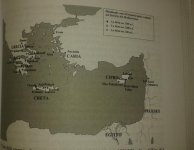Angela
Elite member
- Messages
- 21,823
- Reaction score
- 12,329
- Points
- 113
- Ethnic group
- Italian
I guess I didn't explain myself clearly. Whatever effect these peoples might have had on coastal Sardinians or Italians has nothing to do with the sample from the mountainous, remote region of Sardinia chosen by Cavalli Sforza, who obviously knew what he was doing. There's also the fact that many scholars believe the Sardinians were actually part of the Sea Peoples. Plus, that would in no way explain the 22% Caucasus in 3300 BC Oetzi, which is more than the relic Sardinian group has.It's necessary to take into account the Sea Peoples to count about a Caucasian plus. Denyen, Peleset (Philistines), Shekelesh (Sikules), Sherden (Sardinian), Teresh (Tursa / Etruscan), Tjekker, Weshesh, Lukka (Lycians), Eqwesh (Achaeans), which seem to have a nucleus in the Aegean.
Sorry, that explanation won't fly.


